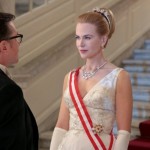Roman Polanski began his illustrious career in 1962 at age 32 with an Academy Award for his film debut, Knife in the Water. Almost the entire film takes place over a short period on a yacht with a cast of just three.
Now, towards the end of his career, with Venus in Fur, the 80-year-old Director and co-writer downsizes and brings the action closer to home with electrifying results. The entire two-hander, based on co-writer David Ives stage play, Venus in Furs, takes place in a theatre in Polanski’s adopted home of Paris on one evening.
Polanski’s wife of 25 years, the actress Emmanuelle Seigner (who has starred in Polanski’s Ninth Gate, Bitter Moon and Frantic) plays an actress. Mathieu Amalric (Quantum of Solace, The Diving Bell and The Butterfly) plays a playwright who looks eerily similar to a younger Polanski and whose mother is, like Polanski, a Polish-born naturalized French citizen.
On a stormy evening, playwright/ director Thomas (Amalric) is preparing to leave an elegant old theatre after an exhausting and fruitless day of auditions. Suddenly, a disheveled woman (Seigner) blows into the theatre like a hurricane, half drowned rat and half bag lady, cursing in a guttural accent everything that made her late.
Under her coat she has dressed for her audition of Leopold von Sacher –Masoch’s 1870 novel Venus in Furs: a revealing black leather dominatrix outfit with a dog collar around her neck.
Thomas tells this unlikely candidate that the auditions are over, but the woman shoves a crumpled, CV in Thomas’s face, bearing a credit from the Urinal Theatre. She introduces herself as Vanda. Aside from the thunder storm, this is our first clue that we are watching a psychological thriller as, curiously, the heroine in Sacher-Masoch’s novel is named Wanda.
Ignoring Thomas’s protests, Vanda pulls a period dress out of a huge bag and restyles her hair – winning the right to read a few lines. She entices Thomas into playing his own male character, and produces, out of her bag, a perfectly fitting smoking jacket to help him into character.
As form and content merge, Vanda begins to take control of her audition, redesigning the lighting (this is no amateur) and moving the stage sets. More surprises are in store for Thomas as he notes with astonishment that Vanda has somehow memorized the script already.
He is dumbfounded when she adopts the accent and posture of the aristocratic Austrian countess Wanda. In fact, she gets into character so convincingly that Thomas loses himself in his role, and gradually becomes the enslaved Severin.
During the course of the ‘audition’, the roles of self-important writer/director and the suppliant unemployed actress are cleverly reversed, mirroring the novel and play. In the novel, it was Severin’s fantasy to be enslaved and abused by a prim and proper woman. Meanwhile, Wanda takes her new role to heart until Severin’s fantasy becomes a frightening reality.
Polanski creates this psychological game before our eyes with such skill that the viewer, too, gets lost in the layers of reality and fantasy, struggling to tell who is speaking: the disheveled 21st century actress, the 19th century countess, Wanda the dominatrix or the mystery woman who claims her name is Vanda and comments on the play from the stage.
This is a tour de force performance from Seigner who effortlessly slips from one persona to another. While Amalric’s transformation and loss of ground is equally convincing, Seigner carries the film with a career best performance. That both actors are in their late 40s –considerably older than the original characters – adds another layer of meaning to a film about appearance and reality, and our ability to transform ourselves.
Four years ago Polanski made a film of another hit New York play, Carnage, but, here, as a further challenge to his two actors, he retains the enclosed, theatrical setting. He even emphasizes the artificial nature of the production by sending us, with the camera, panning down the boulevard, through the theatre’s self-opening doors and down the aisle to where Thomas is first seen. In doing this Polanski uses the hackneyed, and slightly boring, sadomasochist façade as a metaphor for the transformative power of cinema, where reality and fantasy are willing adversaries in a game of wit and disguise.
Polanski maintains the artifice by turning the end title sequence into an art history slide show, as the novel’s title, Venus in Furs, comes from Titian’s influential masterpiece, Venus with a Mirror. And who better to hold up a mirror to reality than Roman Polanski?
Joyce Glasser – MT film reviewer




